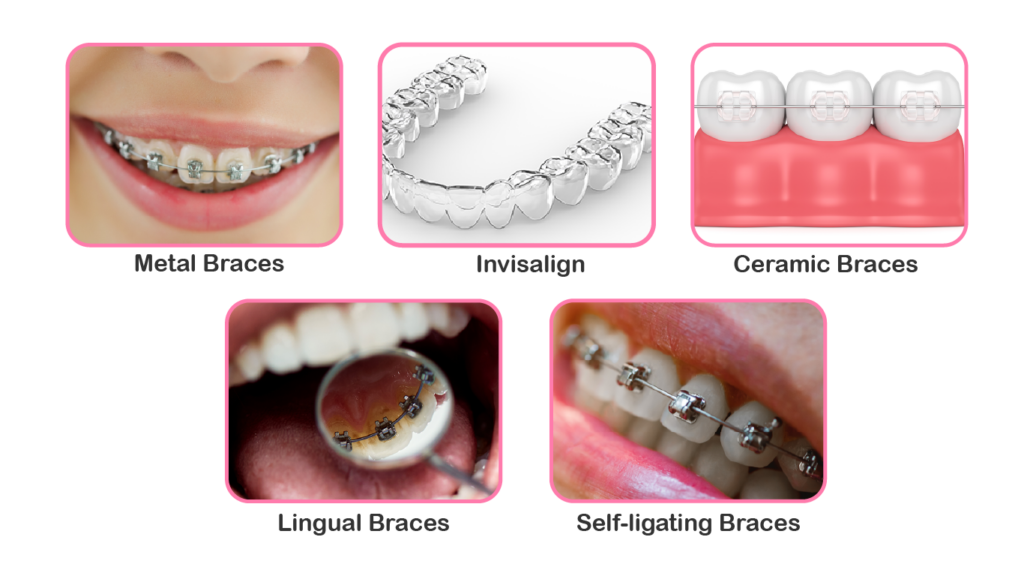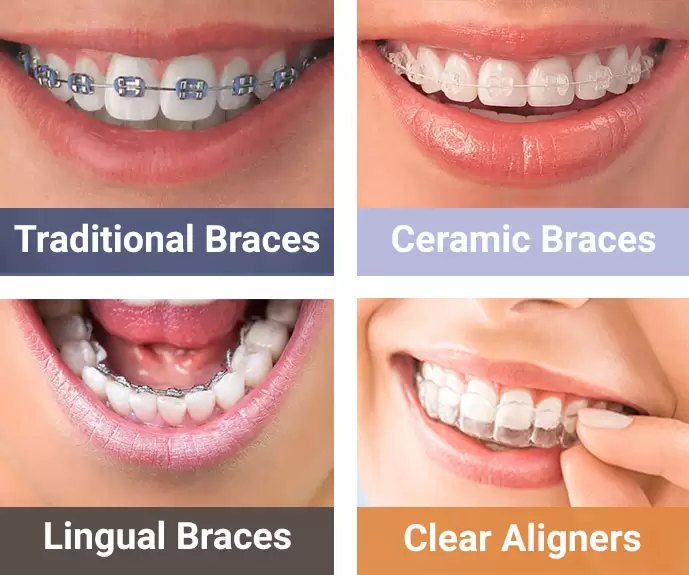Dental braces are a common solution for correcting crowded or crooked teeth and misaligned jaws. While braces are most commonly used during adolescence, it’s becoming increasingly common for adults to also opt for braces. These braces, which consist of metal or ceramic brackets and wires, exert pressure on the teeth and jawline to gradually move them into their desired position.
There are several different types of braces available, including metal braces, ceramic braces, lingual braces, and invisible aligner trays. The purpose of braces is to apply constant pressure on the teeth, which allows the jaw to adapt and the teeth to slowly shift into their proper places. Although braces may cause some discomfort or soreness, over-the-counter pain relievers can help manage any pain. The cost of braces can vary, and coverage may depend on your insurance plan. Many orthodontists offer payment plans to make braces more affordable. Treatment time with braces can range from one to three years, but the duration varies for each individual. It’s important to note that adults can also benefit from braces, although the timing and treatment process may differ compared to children. Proper maintenance of braces involves avoiding certain foods, regularly visiting the dentist, and practicing good oral hygiene. Brushing after meals, using special floss for braces, and incorporating interdental toothbrushes into your routine can help maintain oral health while wearing braces. Overall, braces not only enhance the appearance of your teeth but also contribute to improved overall oral health.

Metal Braces
Metal braces are the traditional type of braces that have been used for many years to correct crowded or crooked teeth and misaligned jaws. They consist of metal brackets and wires that are attached to the teeth. The brackets are then connected by the wires, which apply pressure to the teeth and jawline, gradually moving them into their correct position.
Pros
One of the main advantages of metal braces is their durability. They are built to last and can withstand the pressure exerted during the treatment process. Metal braces are also more cost-effective compared to other options, making them a popular choice for those on a budget. Another benefit is that metal braces are highly effective and can address even the most severe orthodontic issues.
Cons
One of the main drawbacks of metal braces is their appearance. The metal brackets and wires are highly visible and can be a source of self-consciousness for some individuals. Metal braces can also cause discomfort and irritation, particularly when the wires are adjusted. Additionally, maintaining proper oral hygiene can be more challenging with metal braces as they can trap food particles and make brushing and flossing more difficult.
Ceramic Braces
Ceramic braces are similar to metal braces in terms of function but are made of a tooth-colored material that blends in with the teeth, making them less noticeable.
Pros
One of the main advantages of ceramic braces is their aesthetic appeal. The tooth-colored brackets are much less noticeable than their metal counterparts, making them a preferred choice for individuals who are concerned about their appearance during the treatment process. Ceramic braces are also durable and highly effective in aligning the teeth and correcting orthodontic issues.
Cons
Despite their aesthetic appeal, ceramic braces have some drawbacks. They are more prone to staining and discoloration, particularly if proper oral hygiene is not maintained. The brackets of ceramic braces can also be larger and more fragile compared to metal braces, which can increase the risk of breakages or dislodgment. Ceramic braces are also generally more expensive than metal braces, making them less accessible for some individuals.

Lingual Braces
Lingual braces are similar to traditional metal braces, but they are placed on the back surface of the teeth, making them virtually invisible from the front.
Pros
The most notable advantage of lingual braces is their cosmetic appeal. Since they are placed on the back of the teeth, they are hidden from view and offer a discreet treatment option. Lingual braces are also highly effective in correcting orthodontic issues, just like traditional braces.
Cons
Despite their cosmetic appeal, lingual braces have some challenges. They can be more difficult to clean and maintain compared to traditional braces since they are positioned on the back of the teeth. Lingual braces can also cause discomfort and speech difficulties initially, as the tongue adjusts to the presence of the brackets. Additionally, lingual braces are generally more expensive than traditional braces and may not be suitable for all individuals, depending on their specific orthodontic needs.
Invisible Aligner Trays
Invisible aligner trays, such as Invisalign, are a popular alternative to traditional braces. They are made of clear plastic and are custom-made to fit snugly over the teeth, gradually moving them into the desired position.
Pros
One of the main advantages of invisible aligner trays is their appearance. Since they are made of clear plastic, they are virtually invisible when worn, making them a popular choice for individuals who want a discreet treatment option. Invisible aligner trays are also removable, allowing for easier maintenance of oral hygiene and the ability to eat and drink without restrictions.
Cons
While invisible aligner trays have many benefits, they may not be suitable for everyone. They are most effective for mild to moderate orthodontic issues and may not be as effective for more complex cases. Additionally, compliance is essential when using aligner trays as they need to be worn for at least 20-22 hours per day to achieve the desired results. Failure to consistently wear the trays can prolong the treatment process. Invisible aligner trays are also generally more expensive than traditional braces, making them less accessible for some individuals.

Benefits of Braces
Improved Teeth Alignment: The primary goal of braces is to align the teeth properly, improving both their function and appearance. Straighter teeth are easier to clean, reducing the risk of tooth decay and gum disease. Proper alignment also promotes more efficient biting and chewing.
Enhanced Oral Health: Braces can significantly improve oral health by addressing issues such as overcrowding, gaps, and malocclusions. Correcting these issues can make it easier to maintain proper oral hygiene, reducing the risk of cavities, gum disease, and other dental problems.
Boosted Self-Confidence: Braces can have a positive impact on an individual’s self-confidence and self-esteem. By straightening the teeth and improving the smile, braces can help individuals feel more confident in their appearance, leading to improved social interactions and overall well-being.
Considerations for Adults
Timing: While braces are most commonly associated with adolescence, many adults are now seeking orthodontic treatment. The timing for adults getting braces may differ from children, as adult jaws are fully developed and may require different treatment approaches.
Treatment Differences: Adults may have different treatment goals and expectations compared to children. Adult orthodontic treatment may focus more on cosmetic improvements rather than purely functional concerns. Additionally, adults may require additional treatments, such as periodontal care, to ensure optimal results.

Discomfort and Pain Management
Expected Discomfort: It is common to experience some discomfort or soreness when braces are first placed or adjusted. This discomfort is temporary and can be managed with over-the-counter pain relievers such as ibuprofen or acetaminophen. Rinsing with warm saltwater can also help alleviate soreness.
Over-the-Counter Pain Relievers: Over-the-counter pain relievers, such as ibuprofen or acetaminophen, can help manage the discomfort associated with braces. It is essential to follow the recommended dosage and consult a healthcare professional if the pain persists or worsens.
Cost and Coverage
Varied Costs: The cost of braces can vary depending on factors such as the type of braces used, the complexity of the orthodontic issue, and the location of the treatment. It is recommended to consult with an orthodontist to get an accurate estimate of the cost specific to individual needs.
Insurance Coverage: Insurance coverage for braces can vary depending on the insurance plan. Some insurance plans offer coverage for orthodontic treatment, while others may provide partial coverage or none at all. It is crucial to review the insurance policy and consult with the insurance provider to determine the extent of coverage.
Payment Plans: Many orthodontic practices offer payment plans to make braces more affordable. These payment plans allow individuals to pay for treatment over time, often with monthly installments. It is advisable to discuss payment options with the orthodontic practice to find a plan that suits individual financial circumstances.

Treatment Duration
Range of Time: The duration of orthodontic treatment with braces can range from one to three years, depending on the specific orthodontic issue and the type of braces used. Some cases may require longer treatment times, while others may see results sooner.
Individual Variations: Each individual’s orthodontic treatment is unique, and treatment durations can vary. Factors such as compliance with treatment guidelines, oral hygiene practices, and the complexity of the orthodontic issue can influence the treatment duration. It is important to follow the orthodontist’s instructions and attend regular appointments to ensure optimal treatment progress.
Conclusion
Braces offer a highly effective way to correct crowded or crooked teeth and misaligned jaws. Whether you choose metal braces, ceramic braces, lingual braces, or invisible aligner trays, the benefits of braces are numerous. Improved teeth alignment, enhanced oral health, and boosted self-confidence are just some of the advantages braces can provide. While there may be some discomfort and cost considerations, the long-term benefits of braces often outweigh these temporary challenges. If you are considering braces, consult with an orthodontist to determine the best treatment option for your specific needs. Remember, investing in your smile can lead to a lifetime of improved oral health and self-confidence. Contact Us Today!

